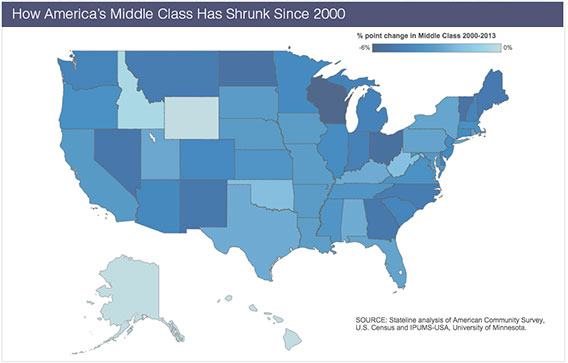If the first decade and a half is any guide, the 21st century will not be known as the era of the middle class in the U.S.
The middle class shrunk in all 50 states between 2000 and 2013, and median income, adjusted for inflation, was lower at the end of 2013 in the vast majority of states than it was in 2000, according to a new study by the Pew Charitable Trust’s Stateline. The analysis, conducted by Stateline’s Tim Henderson, defines “middle class” as individuals earning between 67 percent and 200 percent of the state’s median income.
Related: Why Middle Class Tax Relief Is Taking Center Stage
The study analyzed self-reported data from the Census Bureau through the American Community Survey that samples a percentage of the population including illegal immigrants as well as other data.
“In most states, the growing percentage of households paying 30 percent (the federal standard for housing affordability) or more of their income on housing illustrates that it is increasingly difficult for many American families to make ends meet,” wrote Henderson.
The findings could have some interesting implications for the 2016 presidential race, since the plight of the middle class in states currently governed by some presidential hopefuls is particularly grim.
Wisconsin was the single worst performer, with the percentage of residents in the middle class falling 5.7 percentage points, from 54.6 percent to 48.9 percent over the period studied. Inflation-adjusted median income in the Badger State plunged from $60,344 in 2000 to $51,467 in 2013.
This isn’t good news for Gov. Scott Walker, currently considered a frontrunner for the GOP nomination in 2016. Walker was only in office for the final three years studied, of course, so it would be unfair to blame him for a slide that’s more than a decade old. But nobody said politics was fair.
Related: With Eye on Middle Class, Rubio Floats Tax Plan
Faring almost as poorly as its midwestern neighbor, Ohio saw its middle class shrink by 5.2 percentage points, from 50.9 percent to 45.7 percent. At the same time, median income fell from $56,437 to $48,081. Another potential GOP candidate, Ohio Gov. John Kasich, can’t be terribly pleased by these numbers either – though like Walker, he only took over in 2011.
The numbers will be a little harder to explain for former Texas Gov. Rick Perry, who is also running for the GOP nomination. Perry was in office for the entire period studied and has spent a lot of time bragging about the economic performance of Texas during his tenure. However, the Stateline numbers show that between 2000 and 2013, the middle class in Texas shrunk by 2.6 percentage points, from 47.8 percent to 45.2 percent, as income dropped from $55,019 to $51,704.
Former Florida Gov. Jeb Bush may be somewhat insulated from the study’s numbers, having left office in 2007, but he was running the state for the first half of the period studied. All told, Florida’s middle class shrunk by 2.9 percentage points, from 48.8 percent in 2000 to 45.9 percent in 2013. Income in Florida dropped from $53,493 to $46,036.
Top Reads from The Fiscal Times:





